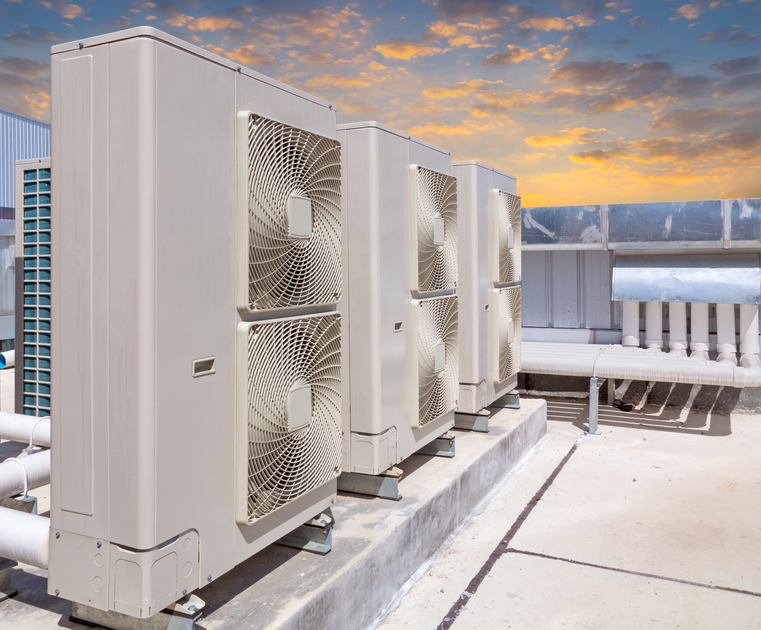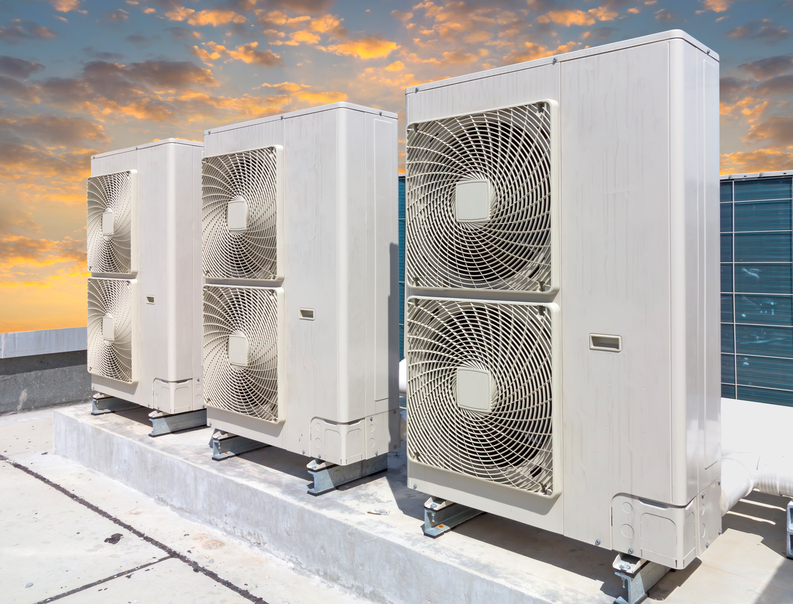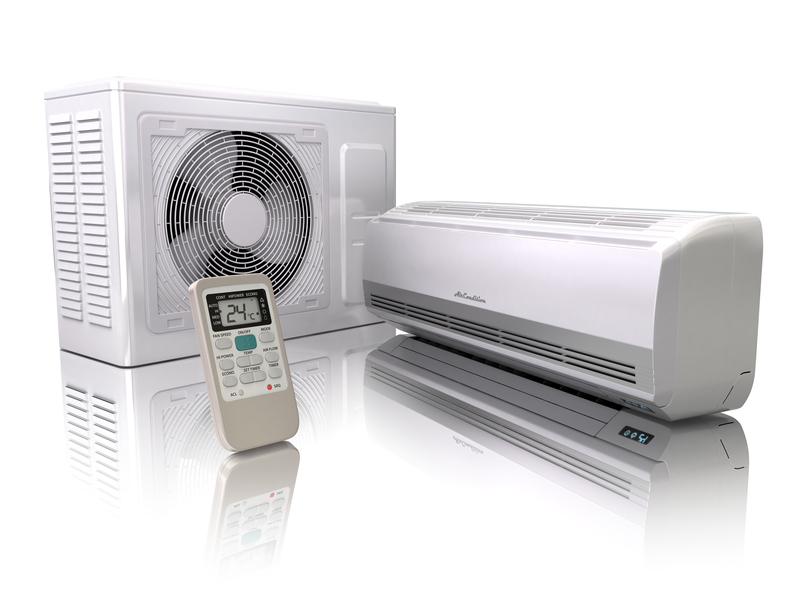HVAC Equipment Design 24 PDH Discount Package
HVAC Equipment and Systems (M08-004)
HVAC Optimization with Cold Air Distribution (M02-026)
HVAC Space Heating Systems (M06-025)
Overview of Chiller Compressors (M04-027)

This online engineering PDH course provides a comprehensive description of the five prominent heat rejection methods as applicable to air conditioning systems.
One of the basic requirements of the air conditioning and refrigeration systems is to reject heat to the outdoors. Air conditioning chillers come in two different forms:
- An air-cooled chiller uses the flow of outside air across the condenser to remove or reject heat from the chiller. Air-cooled chillers typically have the condenser mounted on the roof or somewhere outside the facility while the evaporator can either be inside or outside the facility.
- Water-cooled chillers are typically 100 tons or greater and use water to remove the heat from the condenser. Water-cooled chillers are typically more efficient than air-cooled chillers. The condenser water is kept cool by a cooling tower, or water from the city main or well water is used. A water-cooled chiller will typically have the condenser and evaporator inside a facility while the cooling tower is located outside.
The range of chillers and associated heat rejection equipment is wide ranging.
This 4 PDH online course is applicable to architects, air-conditioning engineers, controls engineers, contractors, environmentalists, energy auditors and loss prevention professionals.
This PE continuing education course is intended to provide you with the following specific knowledge and skills:
- The concept of total heat of rejection (THR), its derivation and how it applies to the process of air conditioning
- Five prominent methods of heat rejection
- Importance of sub-cooling and super-heat in air-cooled condensers
- Types, rating and selection of air cooled condensers
- Operating principle of wet cooling towers
- Types of cooling towers, cross-flow, counter-flow, induced draft and forced draft
- Capacity control of air cooled and water cooled systems
- Closed circuit fluid coolers v/s evaporative condensers
- Energy performance of air-cooled chiller v/s water cooled systems
- Effectiveness of adiabatic cooling technology
- Benefits and limitations of various heat rejection methods
- The selection of appropriate method on capital costs and environment criteria
In this professional engineering CEU course, you need to review the document titled, “Heat Rejection Options in HVAC Systems”.
Upon successful completion of the quiz, print your Certificate of Completion instantly. (Note: if you are paying by check or money order, you will be able to print it after we receive your payment.) For your convenience, we will also email it to you. Please note that you can log in to your account at any time to access and print your Certificate of Completion.

This online engineering PDH course provides information on the various types of HVAC heating and cooling equipments along with associated system design aspects. The course describes how to select appropriate HVAC equipment for your application and how to integrate various components as a working system.
HVAC system components may be grouped into three functional categories: source components, distribution components, and delivery components. Source components provide or remove heat or moisture. Distribution components convey a heating or cooling medium from a source location to portions of a building that require conditioning. Delivery components serve as an interface between the distribution system and occupied spaces.
This course is in continuation to the course titled "HVAC Concepts and Fundamentals", which introduced the basic design aspects, comfort parameters, psychrometrics, heat transfer concepts, heat loss and heat gain calculations and methods to calculate the energy costs, and is posted separately under Course No. M06-012.
This 8 PDH online course is intended for people who plan, design, install, and operate HVAC systems for buildings. Design engineers, architects, designers, contractors, energy auditors, facility managers and maintenance personal should benefit professionally. It is also relevant to anyone needing to know more about HVAC equipment production and use.
This PE continuing education course is intended to provide you with the following specific knowledge and skills:
- Central Heating Sources: Understanding the various types of heating systems available for commercial and residential applications such as furnaces, boilers and heat pumps; familiarizing with the basic selection criteria for heating system and factors considered when designing commercial heating systems.
- Central Cooling Sources: Understanding the various cooling equipments such as mechanical chillers, absorption chillers, DX units, evaporative cooling and cooling towers.
- HVAC Delivery Equipment: Understanding the various heating and cooling delivery equipments such as convective and radiation baseboard units, air handling units, unitary units, fan coil units and their components.
- Air Distribution Ductwork: Learning about air movement, components of air distribution systems, duct classification on velocity, pressure, shape and materials.
- Air Distribution Equipment & Accessories: Learning about air delivery devices such as registers, grilles and diffusers; learning about terminal devices such as dampers, louvers etc.
- System Design: Understanding "all-air" and "all-water" systems including constant air volume, variable air volume, single duct and multi-duct air conditioning systems.
- Hydronic Distribution - Piping and Pumps: Learning about the hydronic loops and understanding the principles of centrifugal pumps.
- Annual Energy Use Calculations: Understanding the concept of balance point temperature and heating and cooling degree days and how to determine annual energy costs.
In this professional engineering CEU course, you need to review the course document tilted, "HVAC Equipment and Systems".
Upon successful completion of the quiz, print your Certificate of Completion instantly. (Note: if you are paying by check or money order, you will be able to print it after we receive your payment.) For your convenience, we will also email it to you. Please note that you can log in to your account at any time to access and print your Certificate of Completion.

This online engineering PDH course outlines the application considerations for the successful design, installation and operation of the cold air HVAC system.
The cold air distribution system refers to supplying air at low temperatures of around 42 to 50°F instead of the customary 55 °F. Cooling supply air below 55°F reduces the supply air volume dramatically, thereby reducing the first cost of the air-handling equipment and recurring energy costs. Humidity levels can be lower within range of 40 to 50%, resulting in improved air quality, comfort and productivity. The physical size of HVAC equipment is smaller, resulting in smaller mechanical rooms, less dead space above ceilings, and more room for occupants.
Cold air production and distribution is not straight forward and requires more attention to details during design phase. This includes detailing to prevent condensation or sweating on the cold surfaces, dumping of cold air and careful selection of ceiling diffusers. Duct leakage is more of a concern and coil selection is based on parameters that are different from conventional designs.
This 2 PDH online course is intended for mechanical, chemical & process engineers, system design engineers working in power, oil & gas, chemical, metal & mining, manufacturing and engineering industries, energy auditors, operational and maintenance personnel who are involved in the planning, design and operation of HVAC systems.
This PE continuing education course is intended to provide you with the following specific knowledge and skills:
- Understanding the design concept of cold air distribution
- Understanding the benefits of cold air distribution
- Learning about cold air relationship to air handling equipment
- Learning about cold air relationship to architectural & mechanical spaces
- Learning about cold air relationship to indoor air quality
- Learning about cold air relationship to energy & cost savings
- Understanding the concerns of cold air distribution (condensation, sweating and dumping)
- Learning about cold air control strategies
- Understanding the design issues
- Utilizing an HVAC optimization checklist
In this professional engineering CEU course, you need to review the document titled, "HVAC Optimization with Cold air Distribution".
Upon successful completion of the quiz, print your Certificate of Completion instantly. (Note: if you are paying by check or money order, you will be able to print it after we receive your payment.) For your convenience, we will also email it to you. Please note that you can log in to your account at any time to access and print your Certificate of Completion.

In this online engineering PDH course we will discuss various active heating options and design considerations for the best fit strategy. We will categorize heating systems in several ways. First we will consider where the primary energy comes from. Then we will ompare the various options and discuss the variety of ways used to deliver heat within the space. Finally, we will discuss some general guidelines on the energy conservation and application strategies for various buildings.
There are almost endless variations and combinations of space heating systems, each having its strengths and limitations. There are two different but related values of interest to the heating system designer: First, to provide comfort and second, to properly select and size the appropriate heating equipment. This requires estimating the annual energy requirements and then analyzing the operating dollar expenses on prevailing fuel costs. Note that the fuel price alone is not the sole measure for selecting a heating system. The broad comparisons on the choice of a heating system is based on various system characteristics such as equipment costs, equipment efficiency, fuel source availability, required system capacity, fuel energy content in millions Btu per unit, environmental impact and heat response or recovery.
This 6 PDH online course is applicable to mechanical and HVAC engineers, architects, building designers, health and safety engineers, energy auditors, occupational physicians, industrial hygienists, facility managers and general audience working with space heat systems.
This PE continuing education course is intended to provide you with the following specific knowledge and skills:
- Understanding how heat loss occurs and what factors affect rate of heat loss
- Ability to estimate the heating load, annual energy usage rate and equipment sizing
- Familiarizing with the primary energy sources and making the comparative analysis
- Understanding the pros & cons of various heating options and ranking the various systems
- Knowing the convective and radiative heat transfer principles
- Knowing the difference between combustion, thermal and distribution efficiency
- Ability to compare among the gas fired and fuel oil fired furnaces
- Understanding the design concepts behind the hot water heating systems
- Knowing the various type of electric resistance and heat pump systems
- Ability to apply energy conservation techniques
- Understanding the various statutory code requirements
- Comparing various heating options and selecting the appropriate system
In this professional engineering CEU course, you need to review the document titled "HVAC Space Heating Systems".
Upon successful completion of the quiz, print your Certificate of Completion instantly. (Note: if you are paying by check or money order, you will be able to print it after we receive your payment.) For your convenience, we will also email it to you. Please note that you can log in to your account at any time to access and print your Certificate of Completion.

This online engineering PDH course provides comprehensive information on the chiller compressors. It addresses the key issues pertaining to the chiller compressor selection and their applications. The practical considerations and assessment criterion are also discussed in brief.
In HVAC industry, the refrigeration machine that produces chilled water is referred to as a "chiller". The majority of installations operating worldwide are based on the vapor compression chillers that use mechanical energy in the form of electric motor to drive the cooling cycle. The vapor compression chiller packages are generally classified by 4 types of compressors namely centrifugal, reciprocating, screw and scroll.
This 4 PDH online course is applicable to HVAC engineers, facility engineers, architects, environmentalists, operations and maintenance personnel, as well as consultants and contractors who construct, build and manage facilities.
This PE continuing education course is intended to provide you with the following specific knowledge and skills:
- Operating principle of reciprocating, screw, centrifugal and scroll compressors
- Key advantages, disadvantages, limitations and drawbacks of various refrigeration compressors
- Efficiency ratings of various chiller options on peak load and part load
- Factors affecting the efficiency of chiller compressors
- Types of refrigerants used/recommended
- Heat rejection options - air cooled vs. water cooled chillers
- Reliability, maintenance, field serviceability of various chiller options
- ARI standard 550/590 performance standard for defining part load performance ratings - IPLV vs. NPLV
- Importance of peak load and part load analysis in determining the overall capacity and number of chillers
- Series and parallel arrangement of chillers
- Operational regimes, infrastructural availability and physical attributes affecting the selection of chillers
- Procurement strategies, performance specifications, life cycle cost considerations
In this professional engineering CEU course, you need to review the document titled, "Overview of Compressor Chillers".
Upon successful completion of the quiz, print your Certificate of Completion instantly. (Note: if you are paying by check or money order, you will be able to print it after we receive your payment.) For your convenience, we will also email it to you. Please note that you can log in to your account at any time to access and print your Certificate of Completion.